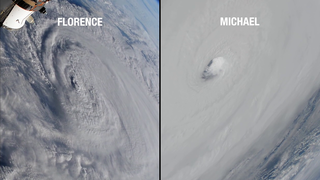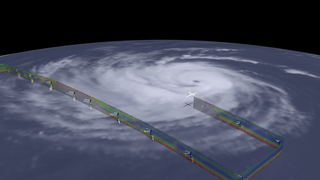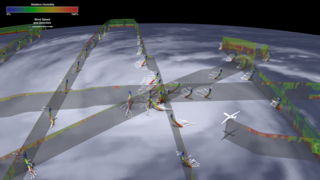Earth
ID: 12821
The swirling nature of hurricane clouds are a familiar sight in satellite imagery, but in order to better understand these storms, scientists need to look inside them. In 2014, NASA's remotely piloted Global Hawk aircraft flew over Hurricane Edouard in the Atlantic Ocean to help better understand what makes hurricanes intensify.
During the 24-hour flight, a sounder instrument measured the relative humidity of the storm from above, where the cloud cover was thin. Where clouds were too thick, including around the eye of the hurricane, the Global Hawk released dropsondes – foot-long sensors that dropped from the aircraft down through the storm to the ocean's surface – sending back data on humidity, temperature and wind the whole way down. Warm, moist air helps to give hurricanes their strength, and near the eye, the red colors show high humidity powering the storm.
Scientists use these and other data collected from these flights to better understand the environmental signals inside and outside of the hurricanes. They want to better understand the signals that lead to rapid intensification where wind speeds dramatically increase in a 24-hour period – vital information for anyone in the storm's path.
Hurricane and Severe Storm Sentinel (HS3) is a mission to investigate the processes that underlie hurricane formation and intensity change in the Atlantic Ocean basin.
NASA Studies Hurricane Edouard in HS3 Mission (2014)
Hurricane and Severe Storm Sentinel (HS3) is a mission to investigate the processes that underlie hurricane formation and intensity change in the Atlantic Ocean basin.
Used Elsewhere In
Source Material
Credits
Scott Braun (NASA/GSFC): Scientist
Kel Elkins (USRA): Animator
Ellen T. Gray (ADNET Systems, Inc.): Writer
Matthew R. Radcliff (USRA): Producer
Kel Elkins (USRA): Animator
Ellen T. Gray (ADNET Systems, Inc.): Writer
Matthew R. Radcliff (USRA): Producer
Please give credit for this item to:
NASA's Goddard Space Flight Center
NASA's Goddard Space Flight Center
Short URL to share this page:
https://svs.gsfc.nasa.gov/12821
Mission:
Hurricanes
This item is part of these series:
Hurricanes
Narrated Movies
Keywords:
DLESE >> Atmospheric science
SVS >> HDTV
DLESE >> Natural hazards
GCMD >> Earth Science >> Atmosphere >> Atmospheric Phenomena >> Hurricanes
GCMD >> Earth Science >> Atmosphere >> Atmospheric Winds >> Wind Profiles
SVS >> Global Hawk
NASA Science >> Earth
GCMD keywords can be found on the Internet with the following citation: Olsen, L.M., G. Major, K. Shein, J. Scialdone, S. Ritz, T. Stevens, M. Morahan, A. Aleman, R. Vogel, S. Leicester, H. Weir, M. Meaux, S. Grebas, C.Solomon, M. Holland, T. Northcutt, R. A. Restrepo, R. Bilodeau, 2013. NASA/Global Change Master Directory (GCMD) Earth Science Keywords. Version 8.0.0.0.0
https://svs.gsfc.nasa.gov/12821
Mission:
Hurricanes
This item is part of these series:
Hurricanes
Narrated Movies
Keywords:
DLESE >> Atmospheric science
SVS >> HDTV
DLESE >> Natural hazards
GCMD >> Earth Science >> Atmosphere >> Atmospheric Phenomena >> Hurricanes
GCMD >> Earth Science >> Atmosphere >> Atmospheric Winds >> Wind Profiles
SVS >> Global Hawk
NASA Science >> Earth
GCMD keywords can be found on the Internet with the following citation: Olsen, L.M., G. Major, K. Shein, J. Scialdone, S. Ritz, T. Stevens, M. Morahan, A. Aleman, R. Vogel, S. Leicester, H. Weir, M. Meaux, S. Grebas, C.Solomon, M. Holland, T. Northcutt, R. A. Restrepo, R. Bilodeau, 2013. NASA/Global Change Master Directory (GCMD) Earth Science Keywords. Version 8.0.0.0.0














